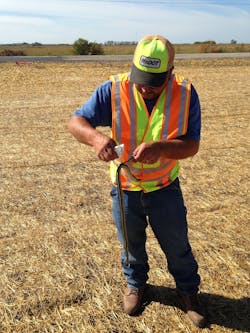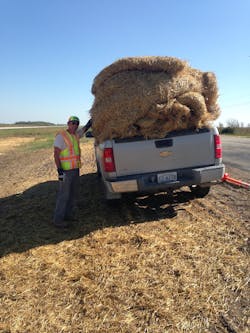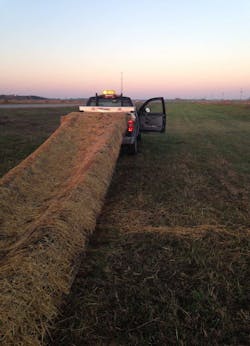A call from a concerned landowner in 2008 prompted the Vermont Agency of Transportation (VTrans) to overhaul its erosion control specifications. The landowner had noticed more than 50 northern water snakes, a state species of greatest conservation need, entangled in plastic erosion control netting along a local road. Chris Slesar, environmental resources coordinator with VTrans, took the call and removed as many snakes as he could. After the incident he asked VTrans engineers if there was a product that would control erosion but allow wildlife to escape.
William Farley, construction services engineer with VTrans, had heard about some biodegradable options that were more flexible than the plastic products. The biodegradable products also met Erosion Control Technology Council (ECTC) standards for erosion control performance. "There's no difference in my opinion as far as performance is concerned," said Farley. He worked with Slesar to change the agency's erosion control specifications.
Some attendees said regulatory and stewardship issues related to wildlife were the main reason their agency transitioned to biodegradable products. Because pieces of plastic netting can contaminate waterways, water quality permit requirements and concerns about human health impacts were major incentives for other agencies. Many soon found practical benefits to making the switch.
Mowing sites where plastic erosion control blankets had been used was difficult when the netting got tangled up in mowing equipment. Even photodegradable plastics can still be on some project sites a decade after construction if vegetation prevents sunlight from breaking down the plastic. In contrast, biodegradable products typically degrade within 1 to 2 years.
There may also be some cost savings across the product's life cycle. For example, in 2017, the Washington State DOT began requiring "natural plant fiber unaltered by synthetic material" in its erosion and sediment control best management practices. Since biodegradable/plant-based BMPs can be left in place after construction, the removal and disposal costs associated with most non-biodegradable products are eliminated. As more DOTs require the use of natural, biodegradable products, the upfront costs of purchasing the product are expected to decrease based on the principles of supply and demand.
DOT staff from various agencies have not observed snakes and other wildlife becoming entangled in the biodegradable blankets. Their observations are supported by research conducted by Dr. Christopher Schalk, assistant professor of Forest Wildlife Management at Stephen F. Austin University. Because natural fiber blankets are loose-weave without joints, snakes are able to move through them. He said the big problem is the fused corners in plastic, which makes the netting less flexible. Snakes also get their scales caught on the rigid plastic. Some agencies have tried using non-welded plastic netting and rapid-degrade plastic netting in their erosion control blankets but didn't find those options attractive. The plastic blankets still don't really go away, eventually breaking down into small pieces of plastic, known as microplastics, that linger in the environment.
Craig Shultz, business development manager with American Excelsior Company, said many manufacturers would love to be part of the conversation about greener erosion control products. "One of the biggest growing markets we see in our world is for the all-natural products," he said, adding that continued improvement of testing standards and performance requirements would help the industry. Testing is necessary, but very expensive. When states have different standards or performance requirements, testing is difficult. Standardization is really key to a manufacturer's success and being able to budget for testing.
U.S. researchers are investigating the potential of hemp and wool to supplement other domestically produced fibers such as wood fiber and straw currently used in erosion control products. The 2018 Farm Bill federally defined hemp as different from marijuana for the first time. Hemp became an agricultural commodity overseen by the USDA as long as it meets the legal definition of hemp: the plant Cannabis sativa with less than 0.3 percent of the psychoactive compound delta-9-tetrahydrocannabinol (THC).
Some challenges to developing hemp include needing to communicate with law enforcement often and obstacles to market development. Farmers want to grow hemp and are seeking more information on how to grow and market the crop. While most states allow some research into hemp as an industry, professors at universities find it difficult to conduct research and outreach on it. There are numerous regulatory and political barriers because of hemp's controversial association with marijuana.
Although it's a crop, it's "a crop with a lot of headaches, a lot of regulations, a lot of stipulations," said Dr. Heather Darby, an extension agronomist at the University of Vermont and a farmer who grows hemp on her own farm. She said farmers are closely watching and cautiously optimistic about the future of hemp. Some states have organized efforts to develop hemp as a crop. In Minnesota, the Agricultural Utilization Research Institute seeks to build a hemp industry in the state and is seeking funding to create prototype products from hemp, such as erosion control blankets for a Minnesota DOT pilot research project.
Research on the performance of wool erosion control blankets is further along. Rob Ament, road ecology program manager with Montana State University, is studying wool erosion control blankets created by Ero-Guard Products for his research. The blankets consist of waste wool that isn't suitable for clothing or army blankets. Ament is using Idaho sites previously dominated by invasive cheatgrass to test how well seeded plants establish under wool erosion control blankets. After two years, results on plant establishment are inconclusive, but he hopes to have more definitive results after this year's data is collected.
Ament said an advantage of wool erosion control blankets is their ability to fertilize the site. Wool, which is 17 percent nitrogen, takes longer than products like straw and coir to break down, slowly decomposing over approximately three years. As wool slowly breaks down, it releases a steady stream of nitrogen for plant growth, unlike fertilizer, which is usually applied in the first year of post-construction revegetation and is only available during the first growing season.
While hemp and wool show potential, more research and development are needed to make these a feasible option for erosion control products. There are also some limitations to transitioning to the biodegradable products that are on the market now. In large agencies it can take time to obtain buy-in and to inform contractors who are still using materials that are not approved by new specifications. Also, supply chains for fibers can change; for example, jute has been difficult to find lately.
Despite these challenges, attendees of the peer exchange wanted DOTs to continue the conversation about ways to reduce plastic and other toxics from roadsides. Some, like Nathan Grider, manager of the impacts assessment section with the Illinois Department of Natural Resources, said agencies should consider the long-term impacts of products used in construction projects. "We're building these things to last 50–100 years," he said. "Let's do it right." SWAuthor's note: To learn more about the peer exchange and follow-up efforts, contact Chris Slesar ([email protected]), Ken Graeve ([email protected]), or Peter Leete ([email protected]).
Kristine Nemec manages the Iowa Roadside Management program at the University of Northern Iowa's Tallgrass Prairie Center. She is also a freelance writer and editor.
Published in Stormwater magazine, May 2021
About the Author

Kristine Nemec
Kristine Nemec manages the Iowa Roadside Management program at the University of Northern Iowa's Tallgrass Prairie Center. She is also a freelance writer and editor.






